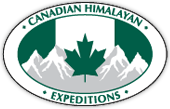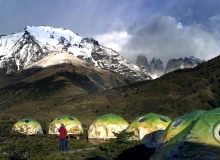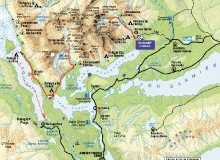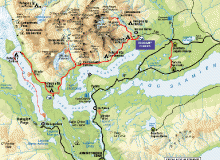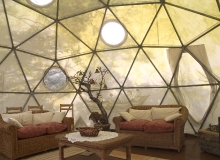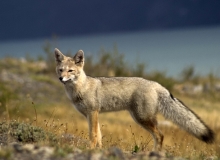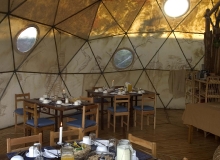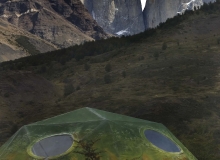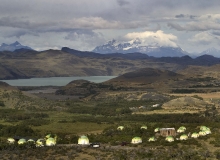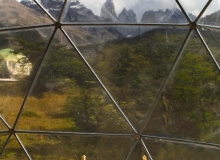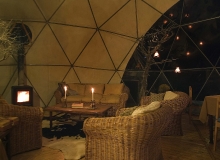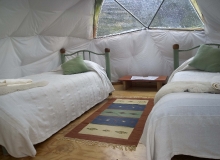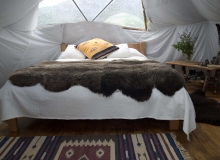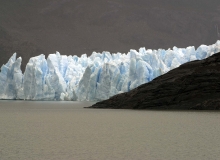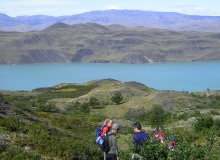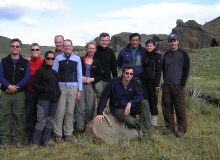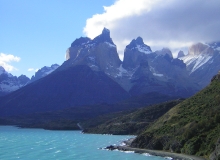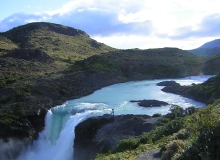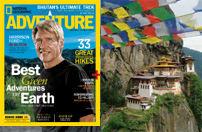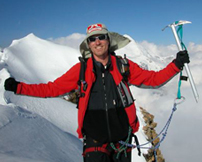Chile/Argentina: Patagonia Explorer with Fitzroy Trek
Map
View HimalayanExpeditions.com in a larger map
The trails between the famous craggy mountains of Torres del Paine in Patagonia are among the world´s classic trekking routes. Breathtaking views of glaciers, rivers, lakes, forests, and abundant wildlife provides the trip with constantly changing scenes and experiences. During summer (Nov-Mar) there are 18 hours of day light which gives us plenty of time for exploring!
The trek itinerary is mostly what is known as the “W”, visiting the Grey glacier and lake, French Valley, Los Cuernos pass and Las Torres. This popular Patagonian trek is suitable for active travelers sensitive to nature and physically fit to make moderate 5-6 hours walks over 5 days. All the day hikes start from the “door” of your tent at either of two camps so just a daypack is carried.
To complement any trip on the Chilean side of Patagonia there is “Los Glaciares National Park” in Argentina. Los Glaciares is one of the most scenically impressive national parks in South America. This vast reserve protects around 2300 square miles of the Patagonean Andes, including over 40 major glaciers. The northern section of the park is dominated by the incredible, world-famous form of the Fitzroy Massif, with its sheer, 6000-foot rise from the glaciers at its base. There are numerous spectacular mountains rising above the immense Lago Viedma, including Fitzroy 3405m (11,072′), and Cerro Torre 3128m (10,280′). The latter is such a steep and difficult granite needle that its summit was not climbed until 1974.The southern section is one of the world’s glacier wonderlands (40 percent of the park is covered by glaciers). About a dozen glaciers flow east to feed two huge lakes, Lago Viedma and Lago Argentino, and there are another 190 glaciers not connected to the park’s giant South Patagonean Icefield.
We will spend several days exploring and hiking through these places of outstanding beauty that have made of Patagonia a true hiker’s paradise at the ends of the earth.
Detailed Itinerary
Arrive Santiago
1
Santiago
2
**OPTION TO START TRIP ON THIS DAY IN PUNTA ARENAS** Travel to Torres del Paine National Park, Patagonia
3
In Paine National Park (Grey Glacier and lake Pehoe)
4
In Paine National Park (Valle del Frances)
5
In Paine National Park (Paso Los Cuernos)
6
In Paine National Park (Towers of Paine, Laguna Azul)
7-8
Cerro Castillo - Calafate - Perito Moreno Glacier
9
Calafate - El Chalten - Fitzroy Camp
10
In Parque Nacional Los Glaciares
11-12
Fitzroy - Calafate
13
Calafate - Puerto Natales
14
Punta Arenas
15
Trip ends ... or
16
Synopsis
Trip Grading:

Length: 16 days
Max. Altitude: 1100m / 3600ft
Begins/Ends in Santiago, Chile
Land Cost: $4750 (per person sharing twin)
Oct 01– Oct 16 ’16
Nov 05 – Nov 20 ’16
Dec 17 – Jan 01 ’17
Dec 31 – Jan 15 ’17
Jan 21 – Feb 05 ’17
Feb 04 – Feb 19 ’17
Feb 11 – Feb 26 ‘17
Feb 18 – Mar 05 ’17
Mar 04 – Mar 19 ’17
Mar 18 – Apr 02 ’17
Apr 01 - Apr 16, '17
Domestic Air ticket: Apx. $495 (Santiago - Punta Arenas)
Single Supplement: Approximately: $475 (For FITZROY TREK the single supplement is for Calafate and Punta Arenas only) Please contact our office for an exact quote.
Trip Details:
Accommodation: The prices correspond to accommodation on a twin share basis. If you are travelling alone and there is no one with whom to share, or if you wish to have single accommodation, then you will be asked to pay a single supplement fee. Accommodations in hotels are based on double or triple occupancy. Accommodation in tents is based on double occupancy.
The hotels in Santiago and major cities are rated 3 to 4 stars with private bathrooms in most cases. In other cases, mainly towns and minor villages, the Inns, Residenciales, Refuges or Cabañas selected provide private or common bath and shower facilities. The criteria for picking out the accommodations are a mixture of: comfort, hygiene, security, location and local atmosphere.
Meals: All meals in the field are included as well as all others in places such as National Parks where the travellers will not be able to purchase their own food, or where we consider it not recommended to do so. Please refer to the trip itinerary for information on which meals are included and not included. The meals included are shown as B=breakfast, L=lunch, L-=box-lunch, D=dinner.
We have put a lot of effort into developing hearty meals for our camping trips and are proud of our farewell dinners. The trip has its own particular menu depending on the local food and typical dishes prepared in the area.
Equipment: Quality camping equipment, including tents and cooking gear is provided.
Unscheduled Delays: On adventure trips of this type, weather conditions, local bureaucracy, transport, or multitude of other factors beyond our control can result in delays or a change of itinerary. It is, however, very unlikely that our schedule would be substantially altered; if alterations are necessary the leader will decide what is the best alternative, taking into consideration the best interest of the whole group.
Where a change does occur, we do everything possible to minimize the effect, but we cannot be responsible for expenses arising from delays or changes to the itinerary.
What you need to bring: Day backpack (10lt), mountain backpack or duffel bag (70 liters), waterproof trekking boots, waterproof parka & pants, inner isolating layer (fleece or wool), three changes of clothes, sun hat, sun screen, hiking socks, sandals (for after hikes), bathing suit, sunglasses, towel (optional), ski poles (optional), long underwear, extra change of socks, flashlight/headlamp, extra insulating layer (fleece, wool, or expedition weight long underwear.
The climate: The vast unbroken stretch of ocean to the west and south of the South American continent leaves the Patagonian Andes very exposed to the saturated winds that circle the Antarctic landmass. Also, the strong marine influence makes the weather hard to predict. In spring or early summer fine weather may deteriorate almost without warning, bringing rain and eventually snow. Even in summer (December to march) you should come prepared to find cold- strong winds (up to 80 km/hr) and rainfalls.
The summers average temperature is 11ºC/ 52ºF (24 ºC max, 2ºC min).
Cost includes(Chilean portion):
* All ground transport as indicated in the itinerary and Park fees.
* Ferry crossing over Lake Pehoe;
* Accommodation sharing a tent in the EcoCamp, upgraded Camp, Los Cuernos refuge.
* Meals as indicated on the itinerary: B=breakfast, L=lunch, L-=Box Lunch, D=dinner
* English speaking trekking guide / One Spanish speaking cook & assistant.
* Complete dining & camping equipment.
Cost includes(Fitzroy portion):
* 5 nights in hosteria in Calafate and Chalten w/private bathroom
* 1 night in hotel in Puerto Natales and Santiago w/private bathroom.
* All domestic transportation
* All meals at Chalten
* Park fees
* One English -speaking trekking guide at passenger ratio of 1/8
Cost excludes: Meals while in cities of Calafate and Punta Arenas.
Note:The Fitzroy trip, rated moderate, is recommended for people in good physical condition in the habit of walking long distances and camping outdoors. All passengers over 65 years old are requested to send ahead a medical examination that states that they are able to safely accomplish moderate hiking.
Eco Camp:
What is the Eco-camp?:
It's a luxury camp, of a kind never seen before in Chile and similar in concept to the famous African lodges. It is a more comfortable alternative, but above all environmentally friendly, especially in a national Park with the characteristics of Torres del Paine.
The Eco-camp has been designed with the comfort of our travellers in mind but above all stressing the importance of interfering as little as possible with the surroundings in which it has been placed.
The need to protect the environment has meant that we have had to be very efficient in managing the eco-camp; this has meant that we cannot offer some of the comforts normal in unprotected areas (private bathroom with septic tank, diesel generators etc) and, on the other hand, utilizing technologies and sustainable processes but ones which demand a greater effort and more patience from our guests (less availability of water and solar energy for electricity, making compost, less waste etc). We think that the camping solution that we have designed for our guests, in one of the most important national parks of the southern hemisphere, is a novel alternative, efficient and in harmony with the current demands of tourism.
What is the eco-camp like?:
Sleeping is in big comfortable domed tents, which take 2 people. They are 2 meters high and the floor is of vitrified wood. The tents are resistant to the strongest winds, rain and even Patagonian snow and they are each equipped with 2 single beds, sheets, blanket and feather cover with heating from a gas stove. The Ecocamp also has a big tent for kitchen/dining room: this is a dome of 9 meters diameter (30 ft) and 4.5 meters high (15 ft). It is equipped with a living area, dining room and kitchen. The space is light and airy with a big panoramic window and it invites our guests to enjoy in a completely new way the surprising evenings of Patagonia. The Ecocamp in Torres also includes a bathroom module (another large dome) with showers and hot water. The toilet system is a compost one (i.e. it transforms human waste into compost). A chef runs the kitchen of the Eco-camp. The rest of the staff in the Eco-camp is composed of a camp host and the circuit guides.
Pehoe Lodge & Fitzroy upgraded camp | Refugios:
Pehoe Lodge & Fitzroy:
Pehoe is located in a strategic location within the park. In this area are our hikes from the Grey Glacier and to the French Valley. The park management has special regulations for Pehoe and there has recently been a new lodge (Refugio) contructed at Pehoe that has very good sleeping, dining, and toilet/shower facilities.
Fitzroy Upgraded camp is somewhat similar to the Torres Ecocamp, but not quite the same standard of facilities. It is located in a strategic place next to the Fitzroy Park and is composed by a larger 9m/30 ft diameter kitchen/dinning/living dome and smaller tents for clients. Bathroom is a 24ft diameter dome fully conditioned with composting toilets and hot showers. By far, the best base camp in the region
Refugios:
Our program includes one night in Los Cuernos refuge. This is a typical mountain refuge, open to the public that visits Torres del Paine and they are run by businesses other than our local operator. It has rooms for 4-6 people. The beds are single, bunk type and we provide you a sleeping bag and a polar fleece liner. The bathrooms are also shared and they have hot water. The refugios are heated and have a dining area.
You can also contact Canadian Himalayan Expeditions directly for more information.
Synopsis
Trip Grading:

Length: 16 days
Max. Altitude: 1100m / 3600ft
Begins/Ends in Santiago, Chile
Land Cost: $4750 (per person sharing twin)
Oct 01– Oct 16 ’16
Nov 05 – Nov 20 ’16
Dec 17 – Jan 01 ’17
Dec 31 – Jan 15 ’17
Jan 21 – Feb 05 ’17
Feb 04 – Feb 19 ’17
Feb 11 – Feb 26 ‘17
Feb 18 – Mar 05 ’17
Mar 04 – Mar 19 ’17
Mar 18 – Apr 02 ’17
Apr 01 - Apr 16, '17
Domestic Air ticket: Apx. $495 (Santiago - Punta Arenas)
Single Supplement: Approximately: $475 (For FITZROY TREK the single supplement is for Calafate and Punta Arenas only) Please contact our office for an exact quote.
Trip Details:
Accommodation: The prices correspond to accommodation on a twin share basis. If you are travelling alone and there is no one with whom to share, or if you wish to have single accommodation, then you will be asked to pay a single supplement fee. Accommodations in hotels are based on double or triple occupancy. Accommodation in tents is based on double occupancy.
The hotels in Santiago and major cities are rated 3 to 4 stars with private bathrooms in most cases. In other cases, mainly towns and minor villages, the Inns, Residenciales, Refuges or Cabañas selected provide private or common bath and shower facilities. The criteria for picking out the accommodations are a mixture of: comfort, hygiene, security, location and local atmosphere.
Meals: All meals in the field are included as well as all others in places such as National Parks where the travellers will not be able to purchase their own food, or where we consider it not recommended to do so. Please refer to the trip itinerary for information on which meals are included and not included. The meals included are shown as B=breakfast, L=lunch, L-=box-lunch, D=dinner.
We have put a lot of effort into developing hearty meals for our camping trips and are proud of our farewell dinners. The trip has its own particular menu depending on the local food and typical dishes prepared in the area.
Equipment: Quality camping equipment, including tents and cooking gear is provided.
Unscheduled Delays: On adventure trips of this type, weather conditions, local bureaucracy, transport, or multitude of other factors beyond our control can result in delays or a change of itinerary. It is, however, very unlikely that our schedule would be substantially altered; if alterations are necessary the leader will decide what is the best alternative, taking into consideration the best interest of the whole group.
Where a change does occur, we do everything possible to minimize the effect, but we cannot be responsible for expenses arising from delays or changes to the itinerary.
What you need to bring: Day backpack (10lt), mountain backpack or duffel bag (70 liters), waterproof trekking boots, waterproof parka & pants, inner isolating layer (fleece or wool), three changes of clothes, sun hat, sun screen, hiking socks, sandals (for after hikes), bathing suit, sunglasses, towel (optional), ski poles (optional), long underwear, extra change of socks, flashlight/headlamp, extra insulating layer (fleece, wool, or expedition weight long underwear.
The climate: The vast unbroken stretch of ocean to the west and south of the South American continent leaves the Patagonian Andes very exposed to the saturated winds that circle the Antarctic landmass. Also, the strong marine influence makes the weather hard to predict. In spring or early summer fine weather may deteriorate almost without warning, bringing rain and eventually snow. Even in summer (December to march) you should come prepared to find cold- strong winds (up to 80 km/hr) and rainfalls.
The summers average temperature is 11ºC/ 52ºF (24 ºC max, 2ºC min).
Cost includes(Chilean portion):
* All ground transport as indicated in the itinerary and Park fees.
* Ferry crossing over Lake Pehoe;
* Accommodation sharing a tent in the EcoCamp, upgraded Camp, Los Cuernos refuge.
* Meals as indicated on the itinerary: B=breakfast, L=lunch, L-=Box Lunch, D=dinner
* English speaking trekking guide / One Spanish speaking cook & assistant.
* Complete dining & camping equipment.
Cost includes(Fitzroy portion):
* 5 nights in hosteria in Calafate and Chalten w/private bathroom
* 1 night in hotel in Puerto Natales and Santiago w/private bathroom.
* All domestic transportation
* All meals at Chalten
* Park fees
* One English -speaking trekking guide at passenger ratio of 1/8
Cost excludes: Meals while in cities of Calafate and Punta Arenas.
Note:The Fitzroy trip, rated moderate, is recommended for people in good physical condition in the habit of walking long distances and camping outdoors. All passengers over 65 years old are requested to send ahead a medical examination that states that they are able to safely accomplish moderate hiking.
Eco Camp:
What is the Eco-camp?:
It's a luxury camp, of a kind never seen before in Chile and similar in concept to the famous African lodges. It is a more comfortable alternative, but above all environmentally friendly, especially in a national Park with the characteristics of Torres del Paine.
The Eco-camp has been designed with the comfort of our travellers in mind but above all stressing the importance of interfering as little as possible with the surroundings in which it has been placed.
The need to protect the environment has meant that we have had to be very efficient in managing the eco-camp; this has meant that we cannot offer some of the comforts normal in unprotected areas (private bathroom with septic tank, diesel generators etc) and, on the other hand, utilizing technologies and sustainable processes but ones which demand a greater effort and more patience from our guests (less availability of water and solar energy for electricity, making compost, less waste etc). We think that the camping solution that we have designed for our guests, in one of the most important national parks of the southern hemisphere, is a novel alternative, efficient and in harmony with the current demands of tourism.
What is the eco-camp like?:
Sleeping is in big comfortable domed tents, which take 2 people. They are 2 meters high and the floor is of vitrified wood. The tents are resistant to the strongest winds, rain and even Patagonian snow and they are each equipped with 2 single beds, sheets, blanket and feather cover with heating from a gas stove. The Ecocamp also has a big tent for kitchen/dining room: this is a dome of 9 meters diameter (30 ft) and 4.5 meters high (15 ft). It is equipped with a living area, dining room and kitchen. The space is light and airy with a big panoramic window and it invites our guests to enjoy in a completely new way the surprising evenings of Patagonia. The Ecocamp in Torres also includes a bathroom module (another large dome) with showers and hot water. The toilet system is a compost one (i.e. it transforms human waste into compost). A chef runs the kitchen of the Eco-camp. The rest of the staff in the Eco-camp is composed of a camp host and the circuit guides.
Pehoe Lodge & Fitzroy upgraded camp | Refugios:
Pehoe Lodge & Fitzroy:
Pehoe is located in a strategic location within the park. In this area are our hikes from the Grey Glacier and to the French Valley. The park management has special regulations for Pehoe and there has recently been a new lodge (Refugio) contructed at Pehoe that has very good sleeping, dining, and toilet/shower facilities.
Fitzroy Upgraded camp is somewhat similar to the Torres Ecocamp, but not quite the same standard of facilities. It is located in a strategic place next to the Fitzroy Park and is composed by a larger 9m/30 ft diameter kitchen/dinning/living dome and smaller tents for clients. Bathroom is a 24ft diameter dome fully conditioned with composting toilets and hot showers. By far, the best base camp in the region
Refugios:
Our program includes one night in Los Cuernos refuge. This is a typical mountain refuge, open to the public that visits Torres del Paine and they are run by businesses other than our local operator. It has rooms for 4-6 people. The beds are single, bunk type and we provide you a sleeping bag and a polar fleece liner. The bathrooms are also shared and they have hot water. The refugios are heated and have a dining area.
You can also contact Canadian Himalayan Expeditions directly for more information.
